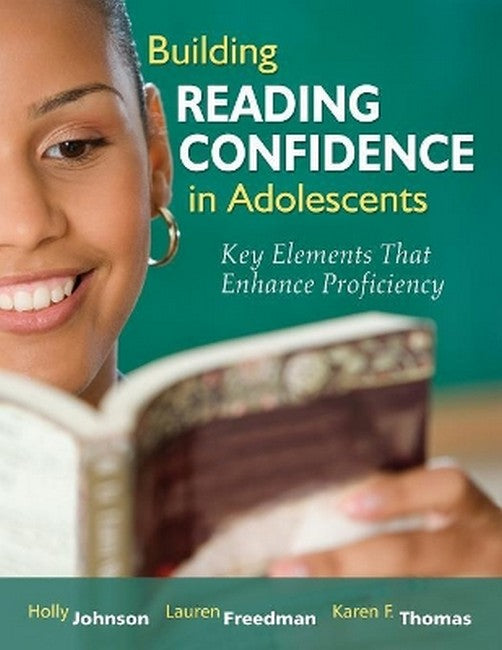Holly Johnson is an Associate Professor in the Division of Teacher Education at the University of Cincinnati. where she teaches adolescent literacy courses for students interested in becoming middle school teachers. Her research focuses on adolescent literacy and literature, and issues of social justice. She taught middle school language arts and social studies in Kentucky and Arizona, and was an industrial arts teacher in Botswana, Africa as a Peace Corps Volunteer. Lauren Freedman is a Professor of Literacy Studies at Western Michigan University. Her primary areas of expertise include the role of self efficacy in literacy development, the use of multiple materials within and across the curriculum, inquiry as a framework for instruction and literacy strategy development, and the role of student-led, small group discussion within learning-centered classroom communities. Karen F. Thomas has been a classroom instructor and administrator in both elementary and middle/high school for 15 years teaching reading and English in urban, public, private and overseas settings before her current teaching at the college level for the 15 plus years. Currently, Thomas is a Professor of Literacy Education at Western Michigan University teaching undergraduate and graduate classes where she also serves as Director of the Dorothy J. McGinnis Reading Center and Clinic and editor of Reading Horizons. She also is involved with a number of community initiatives for literacy as part of the Western Michigan University's Clinic Outreach Program as well as co-investigator for an Early Reading First 3.4 million dollar grant working with Headstart populations.
Request Academic Copy
Please copy the ISBN for submitting review copy form
Description
Introduction Why Is Self-Efficacy Important in Reading? The Purpose of the Text The Audience for This Text Outline of the Text 1. The Four Elements of Reading Self-Efficacy Identifying the Self-Efficacy Elements of C-I-M-S Confidence Independence Metacognition Stamina Self-Efficacy and the Cueing System Learning from Teachers and Students Validating and Violating C-I-M-S Validation of Readers' C-I-M-S Environmental Elements Teaching/Learning Dialectic Curricular Decisions Affective Issues Strategies Violation of Readers' C-I-M-S Concluding Comments 2. A Closer Look at Confidence and Reading What Teachers Have to Say About Confidence and Reading Teaching and Learning Curriculum Planning for Enhancing Reading Confidence Affective Interactions and Confidence Strategies for Building Readers' Confidence What Students Have to Say About Confidence Teaching and Learning Curriculum Planning for Enhancing Reading Confidence Affective Interactions and Confidence Strategies for Building Readers' Confidence Comparing Teacher and Student Thoughts on Reading Confidence An Environment That Builds Confidence Reading in Content Classrooms Classroom Practices for Building Reading Proficiency Strategies for Building Readers' Confidence Class Meetings About Reading Using Authentic Texts Accessing Prior Knowledge Making Connections to Reading Paired Reading With Peers Paired Reading With Younger Readers Word Walls Using Text Sets Retrospective Miscue Analysis Concluding Remarks 3. The Importance of Independence for Gaining Reading Proficiency What Teachers Have to Say About Independence Teaching and Learning Curriculum Planning for Enhancing Reading Independence Affective Interactions and Independence Strategies for Building Readers' Independence What Students Have to Say About Independence Teaching and Learning Curriculum and Reading Affective Interactions and Independence Reading Strategies to Enhance Independence Comparing Teacher and Student Responses to Reading Independence An Environment for Developing Independence Classroom Conditions That Create Reading Independence Scaffolding Reading Independence Strategies for Creating Reading Independence Interest Inventories Silent Reading Questioning the Author Student Think Alouds Note-Taking Skimming, Scanning, Browsing Concluding Remarks 4. A Closer Look at Metacognition and Its Role in Reading Proficiency What Teachers Have to Say About Metacognition Environment Teaching and Learning Relationships Curricular Planning to Foster Metacognitive Awareness Affective Decisions and Metacognition Strategies to Build Metacognition What Students Have to Say About Metacognition and Reading Environment Teaching and Learning Relationships Curricular Decisions Affective Decisions Comparing Teacher and Student Responses to Metacognition Creating More Strategic Readers Are We Preparing Metacognitive Teachers? Concluding Remarks 5. The Significance of Stamina in Reading Proficiency What Teachers Have to Say About Stamina Teaching and Learning Curricular Decisions That Enhance Reading Stamina Affective Decisions and Stamina What Students Have to Say About Stamina and Reading Teaching and Learning Curricular Decisions Affective Decisions Comparing Teacher and Student Thought on Stamina An Environment for Building Readers' Stamina Strategies for Building Readers' Stamina Support Strategies Graphic Organizers Categorization of Information Knowledge Charts Choice Strategies Wondering and Wandering Assessment Strategies Concluding Remarks 6. Developing Curriculum That Addresses Self-Efficacy Addressing Self-Efficacy in the Classroom Curricular and Instructional Models Rigor Relevance Relationship Text Sets of Multiple Print Materials Rigor Relevance Relationship Choice and Voice Rigor Relevance Relationship Sustained Time for Reading, Writing, Talking, Thinking, and Sharing Rigor Relevance Relationship Where Do We Go From Here? References Index
"A tremendous book. Research shows and teachers know that motivation is a central challenge facing teachers today. This text provides fresh insight into self-efficacy, an essential component of motivation, by exploring what it is, how to cultivate it, and how to nurture it in the context of innovative teaching that develops literacy competence in a range of areas." -- Jeffrey D. Wilhelm, Professor of English Education "Both practicing and preservice educators from all content areas need this amazing collection of constructive concepts and strategies that affect adolescent readers' attitudes toward academic and non-academic literacy. This book not only exposes educators to why facilitating engagement with reading is important, but also shares how to help adolescent readers enjoy a lifelong relationship with literacy." -- Vicki Sellers, Language Arts/Social Studies Teacher

